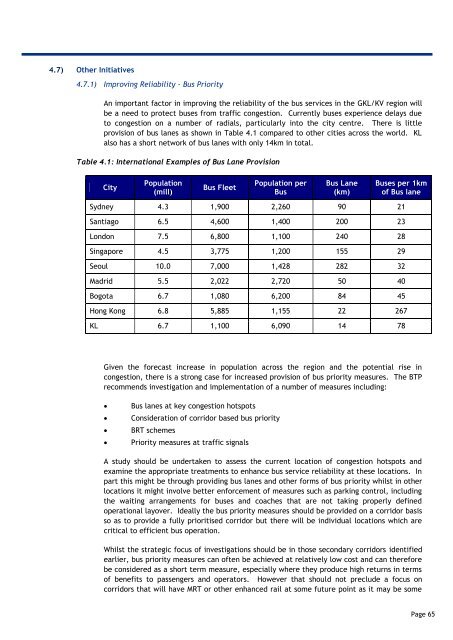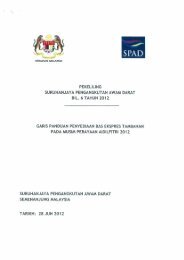Contents - SPAD
Contents - SPAD
Contents - SPAD
You also want an ePaper? Increase the reach of your titles
YUMPU automatically turns print PDFs into web optimized ePapers that Google loves.
4.7) Other Initiatives<br />
4.7.1) Improving Reliability - Bus Priority<br />
An important factor in improving the reliability of the bus services in the GKL/KV region will<br />
be a need to protect buses from traffic congestion. Currently buses experience delays due<br />
to congestion on a number of radials, particularly into the city centre. There is little<br />
provision of bus lanes as shown in Table 4.1 compared to other cities across the world. KL<br />
also has a short network of bus lanes with only 14km in total.<br />
Table 4.1: International Examples of Bus Lane Provision<br />
City<br />
Population<br />
(mill)<br />
Bus Fleet<br />
Population per<br />
Bus<br />
Bus Lane<br />
(km)<br />
Buses per 1km<br />
of Bus lane<br />
Sydney 4.3 1,900 2,260 90 21<br />
Santiago 6.5 4,600 1,400 200 23<br />
London 7.5 6,800 1,100 240 28<br />
Singapore 4.5 3,775 1,200 155 29<br />
Seoul 10.0 7,000 1,428 282 32<br />
Madrid 5.5 2,022 2,720 50 40<br />
Bogota 6.7 1,080 6,200 84 45<br />
Hong Kong 6.8 5,885 1,155 22 267<br />
KL 6.7 1,100 6,090 14 78<br />
Given the forecast increase in population across the region and the potential rise in<br />
congestion, there is a strong case for increased provision of bus priority measures. The BTP<br />
recommends investigation and implementation of a number of measures including:<br />
<br />
<br />
<br />
<br />
Bus lanes at key congestion hotspots<br />
Consideration of corridor based bus priority<br />
BRT schemes<br />
Priority measures at traffic signals<br />
A study should be undertaken to assess the current location of congestion hotspots and<br />
examine the appropriate treatments to enhance bus service reliability at these locations. In<br />
part this might be through providing bus lanes and other forms of bus priority whilst in other<br />
locations it might involve better enforcement of measures such as parking control, including<br />
the waiting arrangements for buses and coaches that are not taking properly defined<br />
operational layover. Ideally the bus priority measures should be provided on a corridor basis<br />
so as to provide a fully prioritised corridor but there will be individual locations which are<br />
critical to efficient bus operation.<br />
Whilst the strategic focus of investigations should be in those secondary corridors identified<br />
earlier, bus priority measures can often be achieved at relatively low cost and can therefore<br />
be considered as a short term measure, especially where they produce high returns in terms<br />
of benefits to passengers and operators. However that should not preclude a focus on<br />
corridors that will have MRT or other enhanced rail at some future point as it may be some<br />
Page 65

















